Effects of Hydrological Drought Periods on Thermal Stability of Brazilian Reservoirs
Abstract
1. Introduction
2. Materials and Methods
2.1. Study Sites
2.2. Drought Assessment
2.3. Hydrodynamic Simulations
2.4. Thermal Regime
2.5. Data Analysis
3. Results
3.1. Drought Period Identification
3.2. Reservoir Thermal Regime
3.3. Schmidt Stability
4. Discussion
4.1. Impacts of Drought Periods on the Management of Reservoirs
4.2. Effects of Drought on Reservoirs’ Thermal Stability
5. Conclusions
Author Contributions
Funding
Data Availability Statement
Acknowledgments
Conflicts of Interest
References
- Blenckner, T. A conceptual model of climate-related effects on lake ecosystems. Hydrobiologia 2005, 533, 1–14. [Google Scholar] [CrossRef]
- Liu, M.; Zhang, Y.; Shi, K.; Zhang, Y.; Zhou, Y.; Zhu, M.; Zhu, G.; Wu, Z.; Liu, M. Effects of rainfall on thermal stratification and dissolved oxygen in a deep drinking water reservoir. Hydrol. Process. 2020, 34, 3387–3399. [Google Scholar] [CrossRef]
- Calderó-Pascual, M.; de Eyto, E.; Jennings, E.; Dillane, M.; Andersen, M.R.; Kelly, S.; Wilson, H.L.; McCarthy, V. Effects of Consecutive Extreme Weather Events on a Temperate Dystrophic Lake: A Detailed Insight into Physical, Chemical and Biological Responses. Water 2020, 12, 1411. [Google Scholar] [CrossRef]
- Mullin, C.A.; Kirchhoff, C.J.; Wang, G.; Vlahos, P. Future projections of water temperature and thermal stratification in Connecticut reservoirs and possible implications for cyanobacteria. Water Resour. Res. 2020, 56, e2020WR027185. [Google Scholar] [CrossRef]
- Barbosa, C.C.; Calijuri, M.d.C.; Santos, A.C.A.d.; Ladwig, R.; Oliveira, L.F.A.d.; Buarque, A.C.S. Future projections of water level and thermal regime changes of a multipurpose subtropical reservoir (Sao Paulo, Brazil). Sci. Total Environ. 2021, 770, 144741. [Google Scholar] [CrossRef]
- Janssen, A.B.G.; Hilt, S.; Kosten, S.; de Klein, J.J.M.; Paerl, H.W.; Van de Waal, D.B. Shifting states, shifting services: Linking regime shifts to changes in ecosystem services of shallow lakes. Freshw. Biol. 2020, 66, 1–12. [Google Scholar] [CrossRef]
- Vogt, J.V.; Naumann, G.; Masante, D.; Spinoni, J.; Cammalleri, C.; Erian, W.; Pischke, F.; Pulwarty, R.; Barbosa, P. Drought Risk Assessment. A Conceptual Framework; EUR 29464 EN; European Union: Luxembourg, 2018. [Google Scholar] [CrossRef]
- Brazil Ministry of the Environment and Climate Change. Brazil: 6th National Report to the Convention on Biological Diversity; Biodiversity Series 55; MMA: Brasília, Brazil, 2023; 1082p. [Google Scholar]
- Marengo, J.A.; Cunha, A.P.; Cuartas, L.A.; Deusdará Leal, K.R.; Broedel, E.; Seluchi, M.E.; Michelin, C.M.; De Praga Baião, C.F.; Chuchón Ângulo, E.; Almeida, E.K.; et al. Extreme Drought in the Brazilian Pantanal in 2019–2020: Characterization, Causes, and Impacts. Front. Water 2021, 3, 639204. [Google Scholar] [CrossRef]
- Islam, T.; Ryan, J. Hazard Mitigation in Emergency Management; Butterworth-Heinemann Elsevier Inc.: Oxford, UK, 2016. [Google Scholar] [CrossRef]
- Kchouk, S.; Melsen, L.A.; Walker, D.W.; van Oel, P.R. A review of drought indices: Predominance of drivers over impacts and the importance of local context. Nat. Hazards Earth Syst. Sci. 2021. [Google Scholar] [CrossRef]
- Kumanlioglu, A.A. Characterizing meteorological and hydrological droughts: A case study of the Gediz River Basin, Turkey. Meteorol. Appl. 2020, 27, e1857. [Google Scholar] [CrossRef]
- Wang, Q.; Zhang, R.; Qi, J.; Zeng, J.; Wu, J.; Shui, W.; Wu, X.; Li, J. An improved daily standardized precipitation index dataset for mainland China from 1961 to 2018. Sci. Data 2022, 9, 124. [Google Scholar] [CrossRef]
- Salimi, H.; Asadi, E.; Darbandi, S. Meteorological and hydrological drought monitoring using several drought indices. Appl. Water Sci. 2021, 11, 11. [Google Scholar] [CrossRef]
- Mckee, T.B.; Doesken, N.J.; Kleist, J. The Relationship of Drought Frequency and Duration to Time Scales. In Proceedings of the 8th Conference on Applied Climatology, Anaheim, CA, USA, 17–23 January 1993; American Meteorological Society: Boston, MA, USA, 1993. [Google Scholar]
- Samuel, J.; Sutanto, S.J.; Fredrik Wetterhall, F.; Van Lanen, H.A.J. Hydrological drought forecasts outperform meteorological drought forecasts. Environ. Res. Lett. 2020, 15, 8. [Google Scholar] [CrossRef]
- Cunha, A.P.M.A.; Zeri, M.; Deusdará Leal, K.; Costa, L.; Cuartas, L.A.; Marengo, J.A.; Tomasella, J.; Vieira, R.M.; Barbosa, A.A.; Cunningham, C.; et al. Extreme Drought Events over Brazil from 2011 to 2019. Atmosphere 2019, 10, 642. [Google Scholar] [CrossRef]
- Soares, L.M.V.; Silva, T.F.G.; Vinçon-Leite, B.; Eleutério, J.C.; De Lima, L.C.; Nascimento, N.O. Modelling drought impacts on the hydrodynamics of a tropical water supply reservoir. Inland Waters 2019, 9, 422–437. [Google Scholar] [CrossRef]
- Hadley, K.R.; Paterson, A.M.; Stainsby, E.A.; Michelutti, N.; Yao, H.; Rusak, J.A.; Ingram, R.; McConnell, C.; Smol, J.P. Climate warming alters thermal stability but not stratification phenology in a small north-temperate lake. Hydrol. Process. 2014, 28, 6309–6319. [Google Scholar] [CrossRef]
- Read, J.S.; Winslow, L.A.; Hansen, G.J.A.; Hoek, J.V.D.; Hanson, P.C.; Bruce, L.C.; Markfortf, C.D. Simulating 2368 temperate lakes reveals weak coherence in stratification phenology. Ecol. Model. 2014, 291, 142–150. [Google Scholar] [CrossRef]
- Hallnan, R.; Saito, L.; Busby, D.; Tyler, S. Modeling Shasta Reservoir Water-Temperature Response to the 2015 Drought and Response under Future Climate Change. J. Water Resour. Plan. Manag. 2020, 146, 5. [Google Scholar] [CrossRef]
- Köppen, W. Climatología: Um Estudio de los Climas de La Tierra [Climatology: A Study of Climates of the Earth]; Fondo de Cultura Económica: Mexico City, Mexico, 1948. [Google Scholar]
- Beguería, S.; Vicente-Serrano, S.M. SPEI: Calculation of the Standardised Precipitation-Evapotranspiration Index, R Package Version 1.7; 2017. Available online: https://CRAN.Rproject.org/package=SPEI (accessed on 15 February 2021).
- World Meteorological Organization (WMO); Global Water Partnership (GWP). Handbook of Drought Indicators and Indices; Svoboda, M., Fuchs, B.A., Eds.; Integrated Drought Management Programme (IDMP), Integrated Drought Management Tools and Guidelines Series 2; World Meteorological Organization and Global Water Partnership: Geneva, Switzerland, 2016. [Google Scholar]
- Instituto Nacional de Meteorologia (INMET). Automatic and Conventional Monitoring Stations. 2022. Available online: http//www.inmet.gov.br (accessed on 15 March 2021).
- Hipsey, M.R.; Bruce, L.C.; Boon, C.; Busch, B.; Carey, C.C.; Hamilton, D.P.; Hanson, P.C.; Read, J.S.; Sousa, E.D.; Weber, M.; et al. A General Lake Model (GLM 3.0) for linking with high-frequency sensor data from the Global Lake Ecological Observatory Network (GLEON). Geosci. Model Dev 2019, 12, 473–523. [Google Scholar] [CrossRef]
- Mesman, J.P.; Ayala, A.I.; Adrian, R.; Eyto, E.D.; Frassl, M.A.; Goyette, S.; Kasparian, J.; Perroud, M.; Stelzer, J.A.A.; Pierson, D.C.; et al. Performance of one-dimensional hydrodynamic lake models during short-term extreme weather events. Environ. Model. Softw. 2020, 133, 104852. [Google Scholar] [CrossRef]
- Agência Nacional De Águas—ANA. Crise da água. Conjuntura dos Recursos Hídricos. 2017, Cap. 5, 39p. Available online: http://conjuntura.ana.gov.br/ (accessed on 3 February 2021).
- CETESB—Environmental Company of São Paulo State. 2021. Available online: https://cetesb.sp.gov.br/ (accessed on 23 January 2021).
- CEB—Energy Company of Brasilia. 2021. Available online: https://www.ceb.com.br/ (accessed on 15 March 2021).
- SANEPAR—Sanitation Company of Paraná. 2022. Available online: https://site.sanepar.com.br/ (accessed on 5 January 2022).
- Soares, L.M.V.; Calijuri, M.d.C.; das Graças Silva, T.F.; de Moraes Novo, E.M.L.; Cairo, C.T.; Barbosa, C.C.F. A parameterization strategy for hydrodynamic modelling of a cascade of poorly monitored reservoirs in Brazil. Environ. Model. Softw. 2020, 134, 104803. [Google Scholar] [CrossRef]
- Fernandes, C.V.S.; Bleninger, T.B.; Kishi, R.T.; Paula, E.V.; Ferreira, D.M.; Nowatski, A.; Pereira, G.H.A.; Bernardo, J.W.Y. RT-SP2-02: Modelagem da Qualidade da Água dos rios de Domínio da União e seus Reservatórios na UGRH Paranapanema, para as Cenarizações nos Horizontes de Planejamento do Prognóstico na UGRH Paranapanema; Research Report; UFPR: Curitiba, Brazil, 2020. [Google Scholar]
- Sales, G.G.N. Water Quality Modeling in a Subtropical Water Supply Reservoir. Master’s Thesis, Universidade Federal do Paraná, Setor de Tecnologia, Programa de Pós-Graduação em Engenharia Ambiental, Curitiba, Brazil, 2020. [Google Scholar]
- Winslow, L.; Read, J.; Woolway, R.; Brentrup, J.; Leach, T.; Zwart, J.; Albers, S.; Collinge, D. rLakeAnalyzer: Lake Physics Tools, R Package Version 1.11.4. 2018. Available online: https://cran.r-project.org/package=rLakeAnalyzer (accessed on 17 July 2020).
- Idso, S. On the concept of lake stability. Limnol. Oceanogr. 1973, 18, 681–683. [Google Scholar] [CrossRef]
- Imberger, J.; John, C.; Patterson, J.C. Physical Limnology. In Advances in Applied Mechanics; John, W., Theodore, H., Wu, Y., Eds.; Elsevier: Amsterdam, The Netherlands, 1989; Volume 27, pp. 303–475. ISSN 0065-2156. [Google Scholar] [CrossRef]
- Read, J.S.; Hamilton, D.P.; Jones, I.D.; Muraoka, K.; Winslow, L.A.; Kroiss, R.; Wu, C.H.; Gaiser, E. Derivation of lake mixing and stratification indices from high-resolution lake buoy data. Environ. Model. Softw. 2011, 26, 1325–1336. [Google Scholar] [CrossRef]
- Wu, B.; Wang, G.; Jiang, H.; Wang, J.; Liu, C. Impact of revised thermal stability on pollutant transport time in a deep reservoir. J. Hydrol. 2016, 535, 671–687. [Google Scholar] [CrossRef]
- Piccioni, F.; Casenave, C.; Lemaire, B.J.; Le Moigne, P.; Dubois, P.; Vinçon-Leite, B. The thermal response of small and shallow lakes to climate change: New insights from 3D hindcast modelling. Earth Syst. Dynam. 2021, 12, 439–456. [Google Scholar] [CrossRef]
- Ishikawa, M.; Gonzalez, W.; Golyjeswski, O.; Sales, G.; Rigotti, J.A.; Bleninger, T.; Mannich, M.; Lorke, A. Effects of dimensionality on the performance of hydrodynamic models for stratified lakes and reservoirs. Geosci. Model Dev. 2022, 15, 2197–2220. [Google Scholar] [CrossRef]
- Waskom, M.L. Seaborn: Statistical data visualization. J. Open Source Softw. 2021, 6, 3021. [Google Scholar] [CrossRef]
- Moreira, A.C.P.; Silveira, P.H.V.; Possetti, G.R.C.; Gonchorosky, J.C. Soluções inovadoras para o enfrentamento aos efeitos da crise hídrica na região metropolitana de Curitiba: Da lagoa de minas à hidrossemeadura de nuvens. In Proceedings of the 8th International Conference in Corporate, Curitiba, Brazil, 3–4 November 2021; pp. 1–10. [Google Scholar]
- Bouvy, M.; Nascimento, S.M.; Molica, R.J.R.; Ferreira, A.; Huszar, V.; Azevedo, S. Limnological features in Tapacura reservoir (northeast Brazil) during a severe drought. Hydrobiologia 2003, 493, 115–130. [Google Scholar] [CrossRef]
- Ishikawa, M.; Gurski, L.; Bleninger, T.; Rohr, H.; Wolf, N.; Lorke, A. Hydrodynamic Drivers of Nutrient and Phytoplankton Dynamics in a Subtropical Reservoir. Water 2022, 14, 1544. [Google Scholar] [CrossRef]
- Watanabe, F.; Rodrigues, T.; Bernardo, N.; Alcântara, E.; Imai, N. Drought can cause phytoplankton growth intensification in Barra Bonita reservoir. Model. Earth Syst. Environ. 2016, 2, 134. [Google Scholar] [CrossRef]
- Mosley, L.M. Drought impacts on the water quality of freshwater systems; review and integration. Earth-Sci. Rev. 2015, 140, 203–214. [Google Scholar] [CrossRef]
- Ladwig, R.; Hanson, P.C.; Dugan, H.A.; Carey, C.C.; Zhang, Y.; Shu, L.; Duffy, C.J.; Cobourn, K.M. Lake thermal structure drives interannual variability in summer anoxia dynamics in a eutrophic lake over 37 years. Hydrol. Earth Syst. Sci. 2021, 25, 1009–1032. [Google Scholar] [CrossRef]
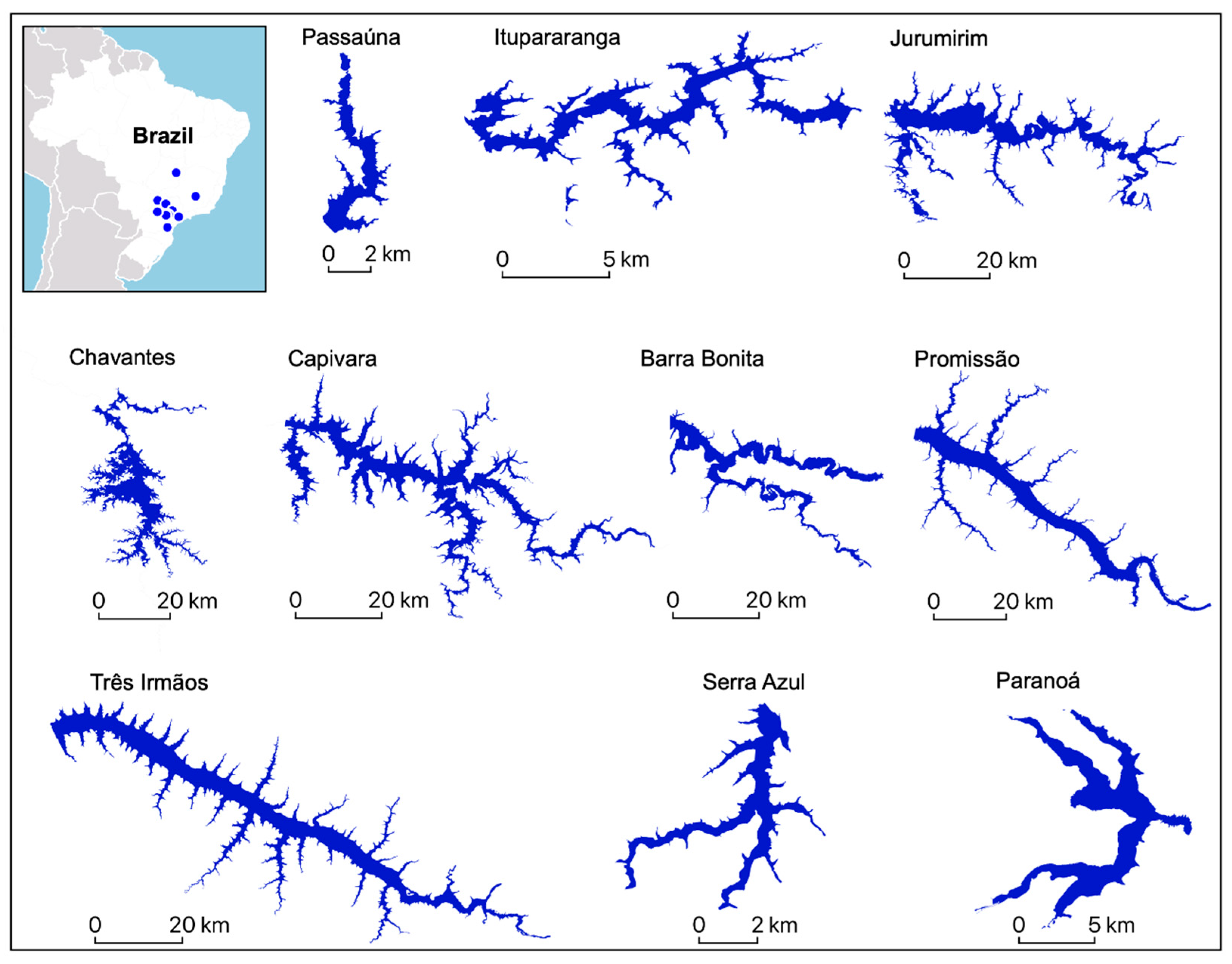
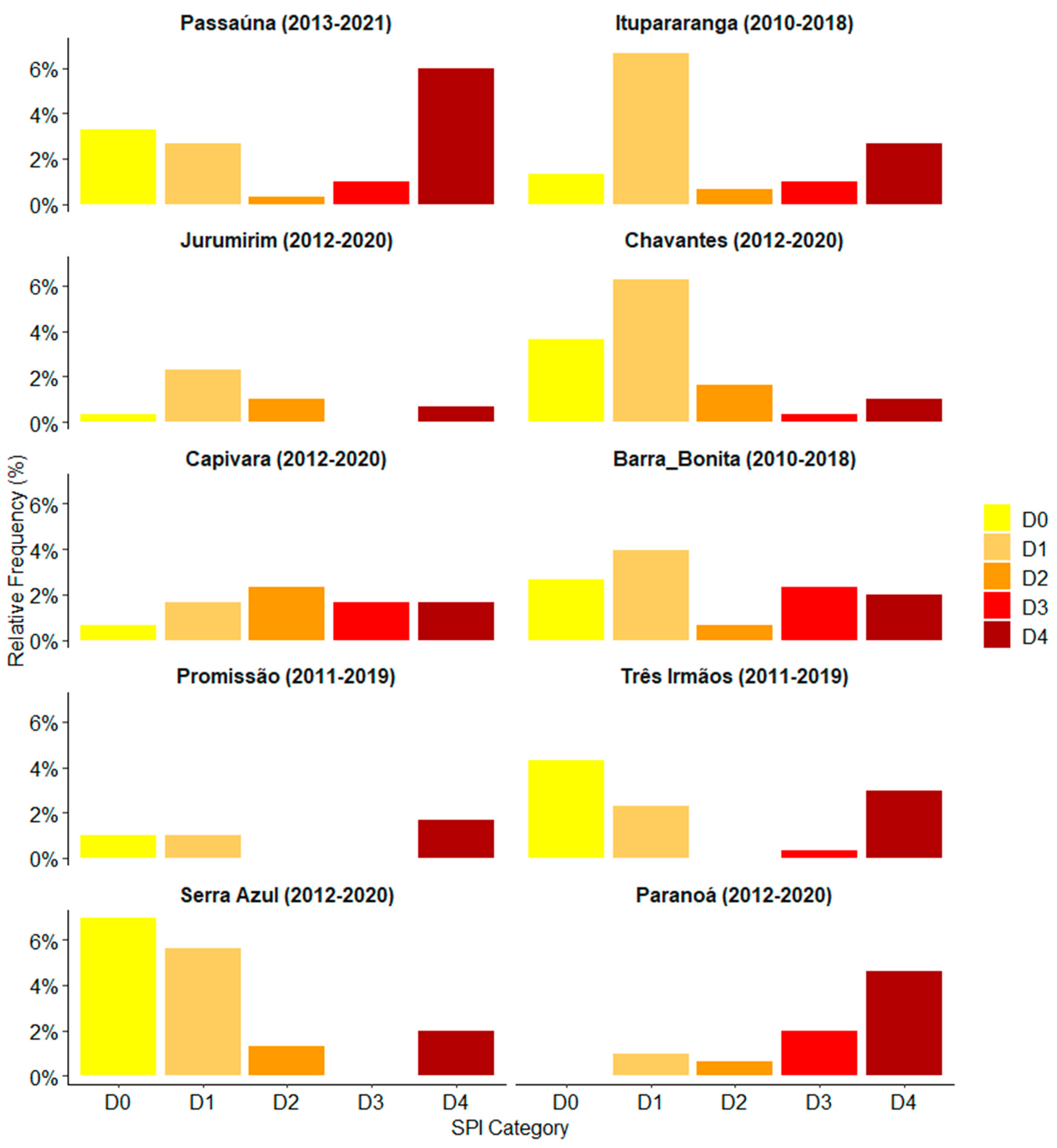
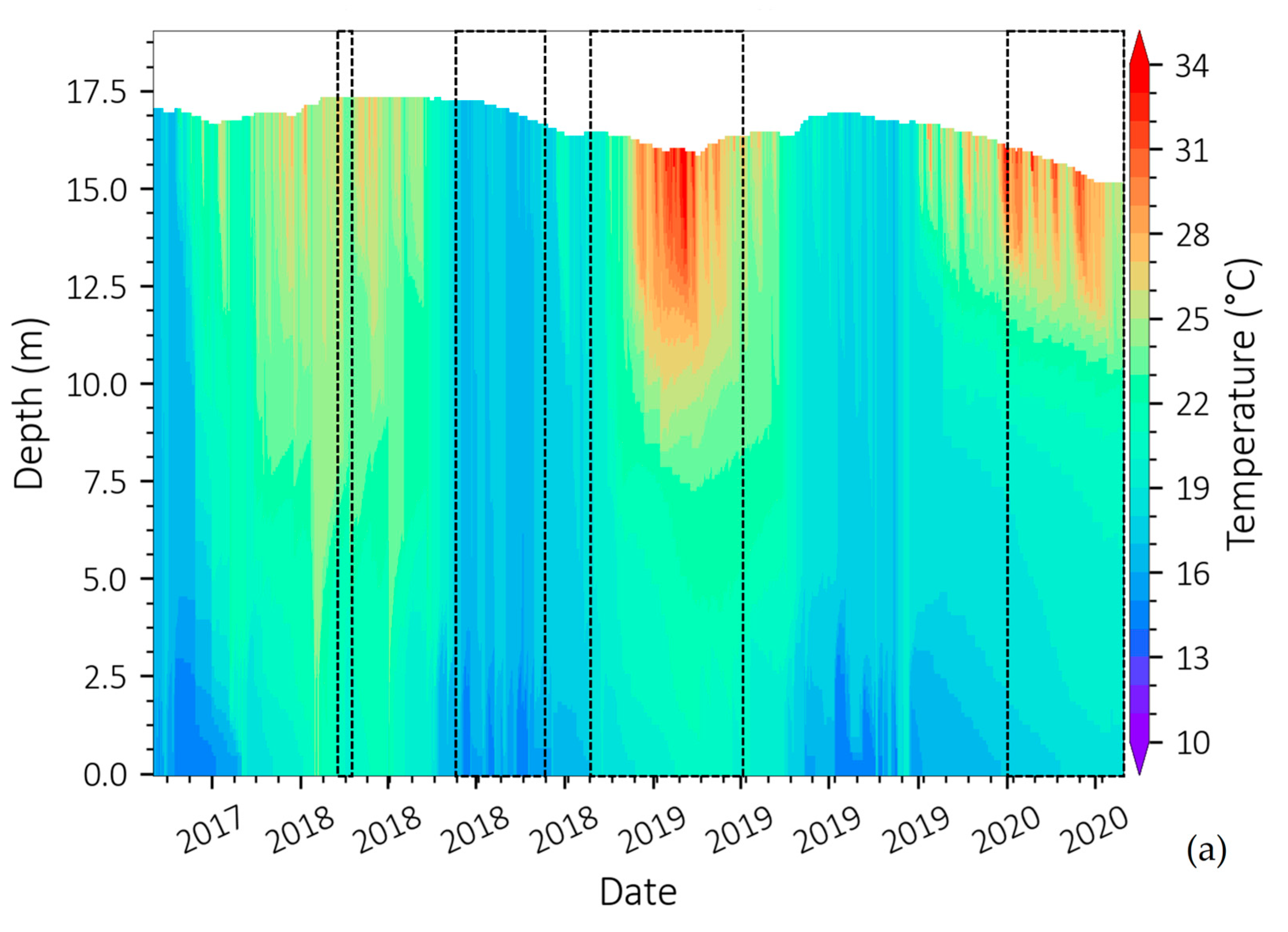

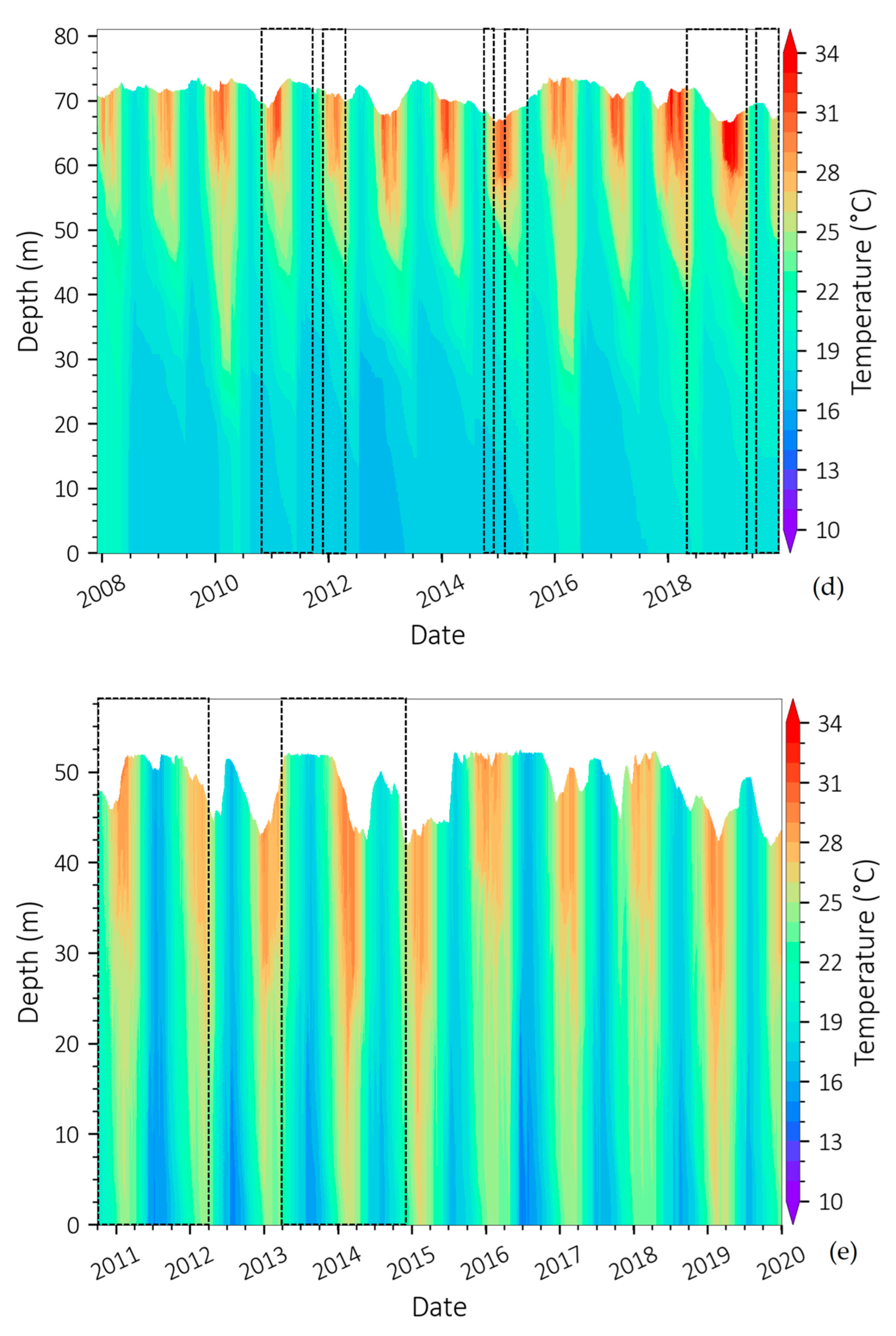

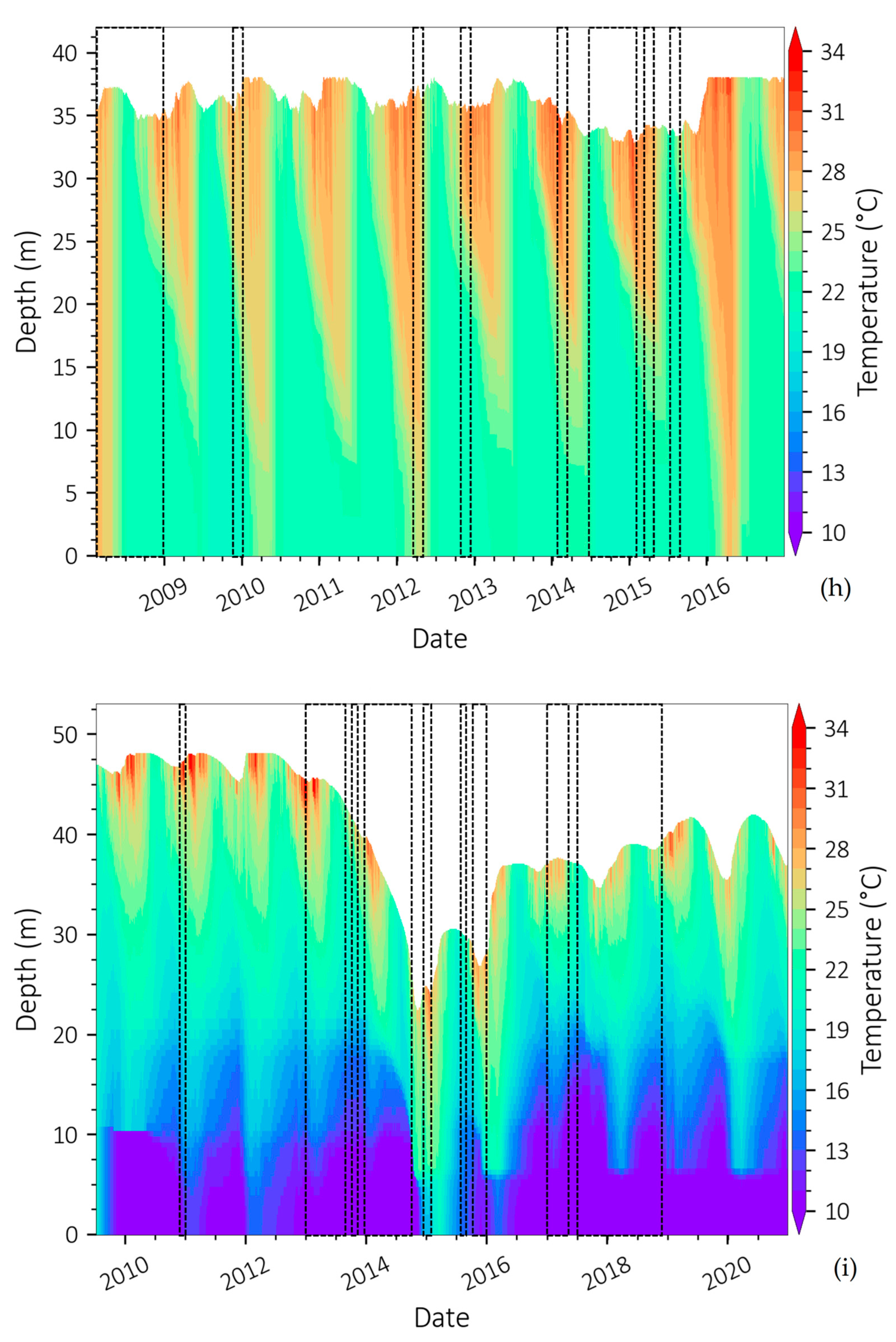
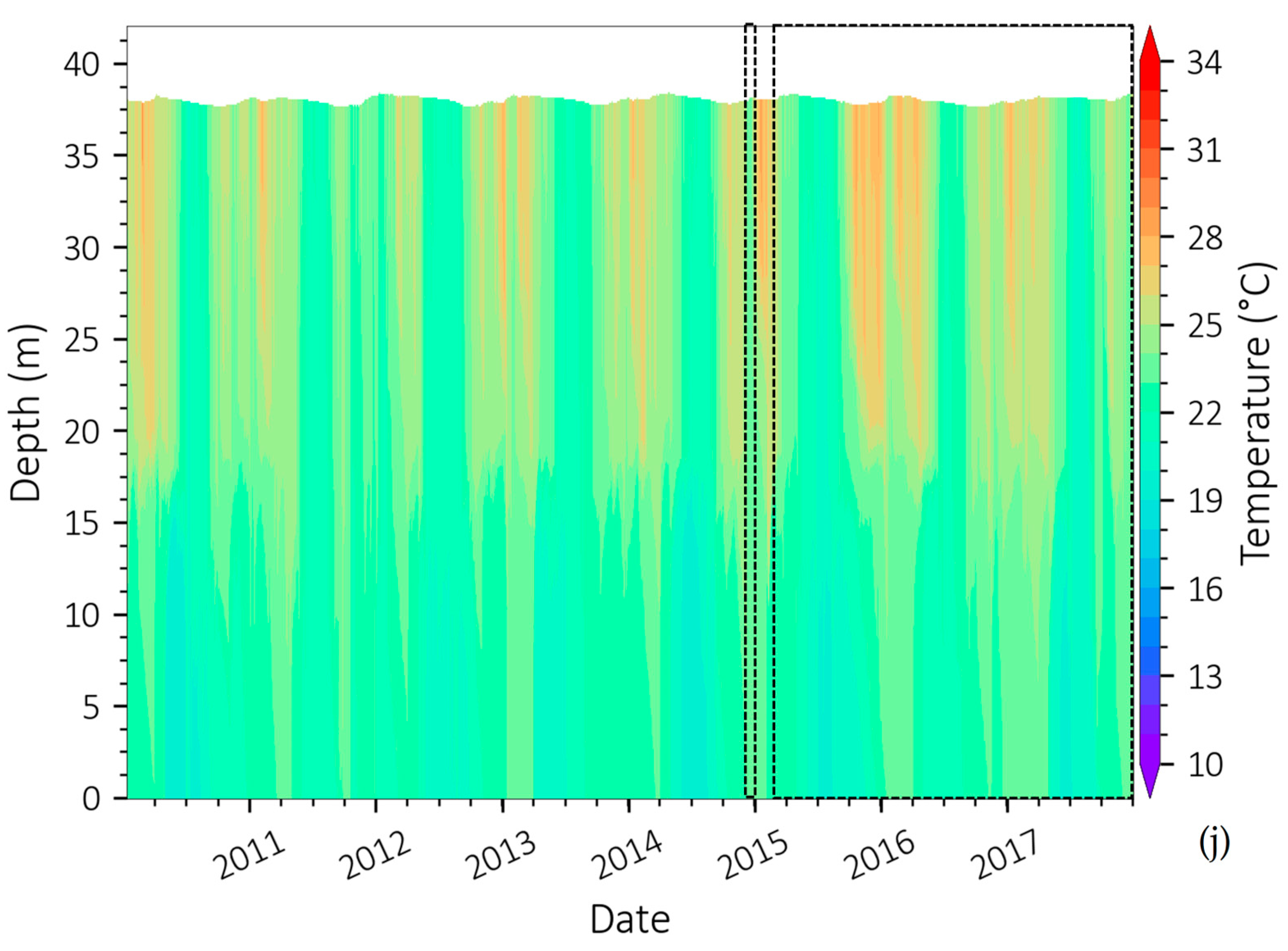
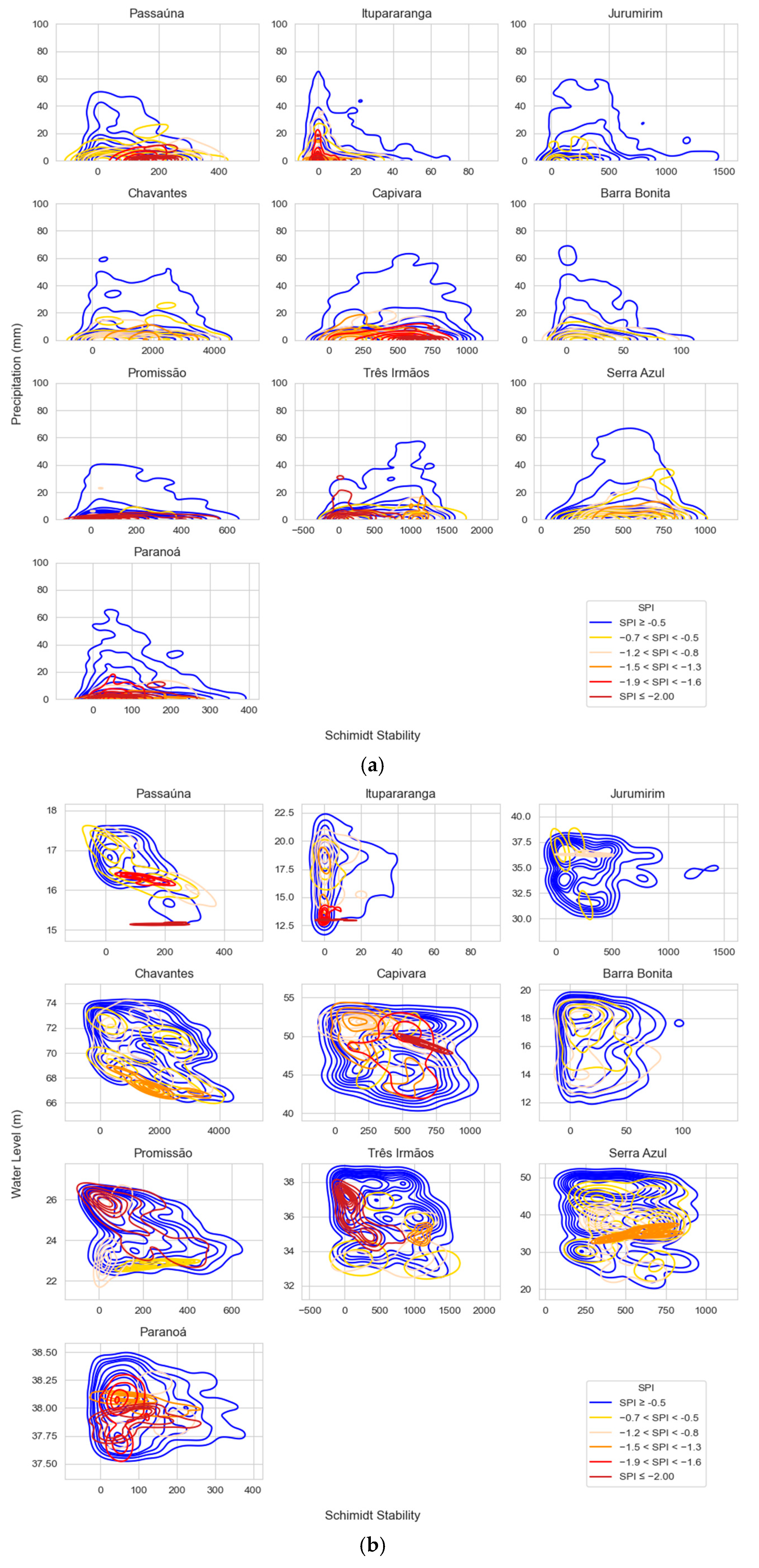
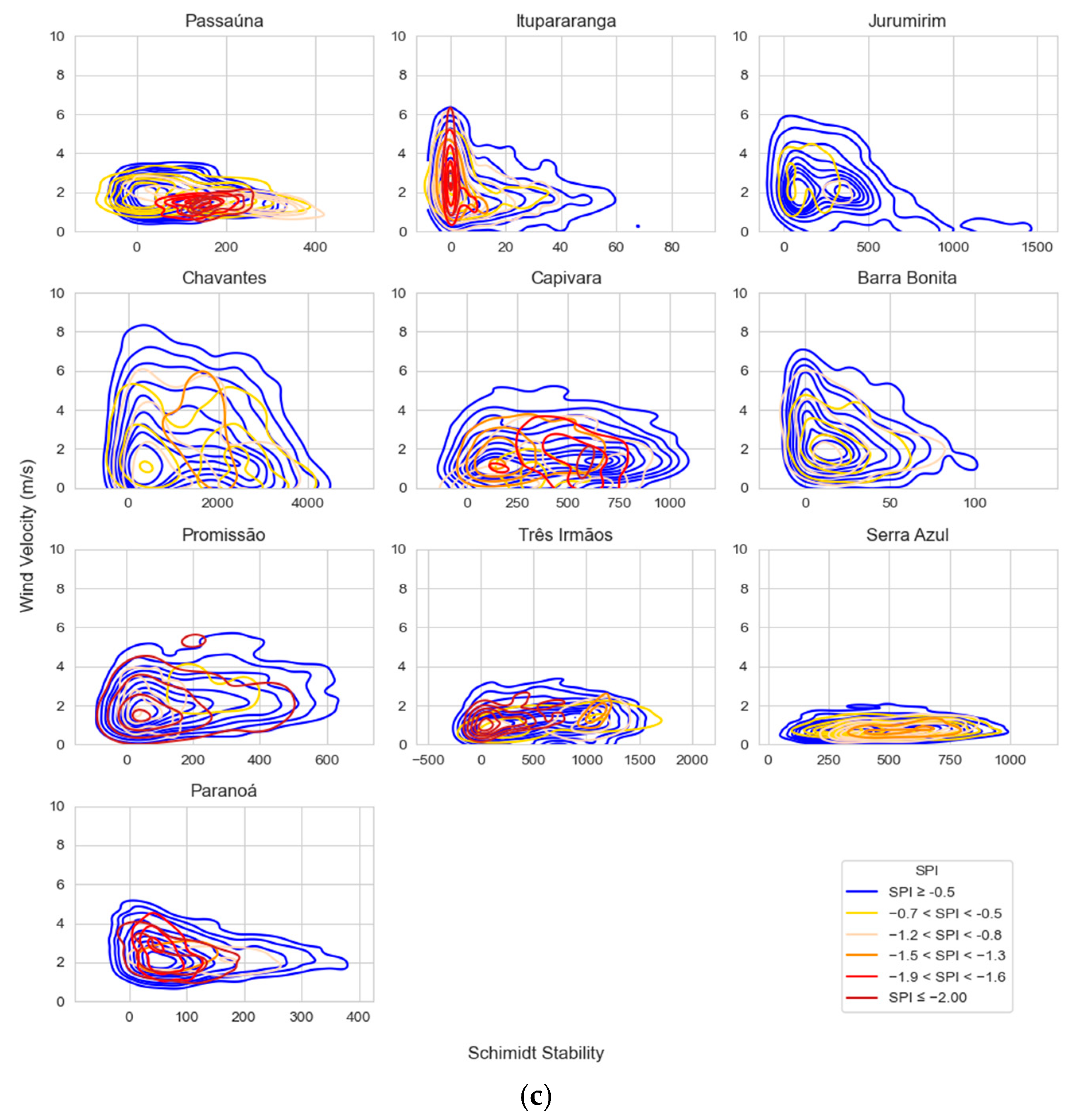
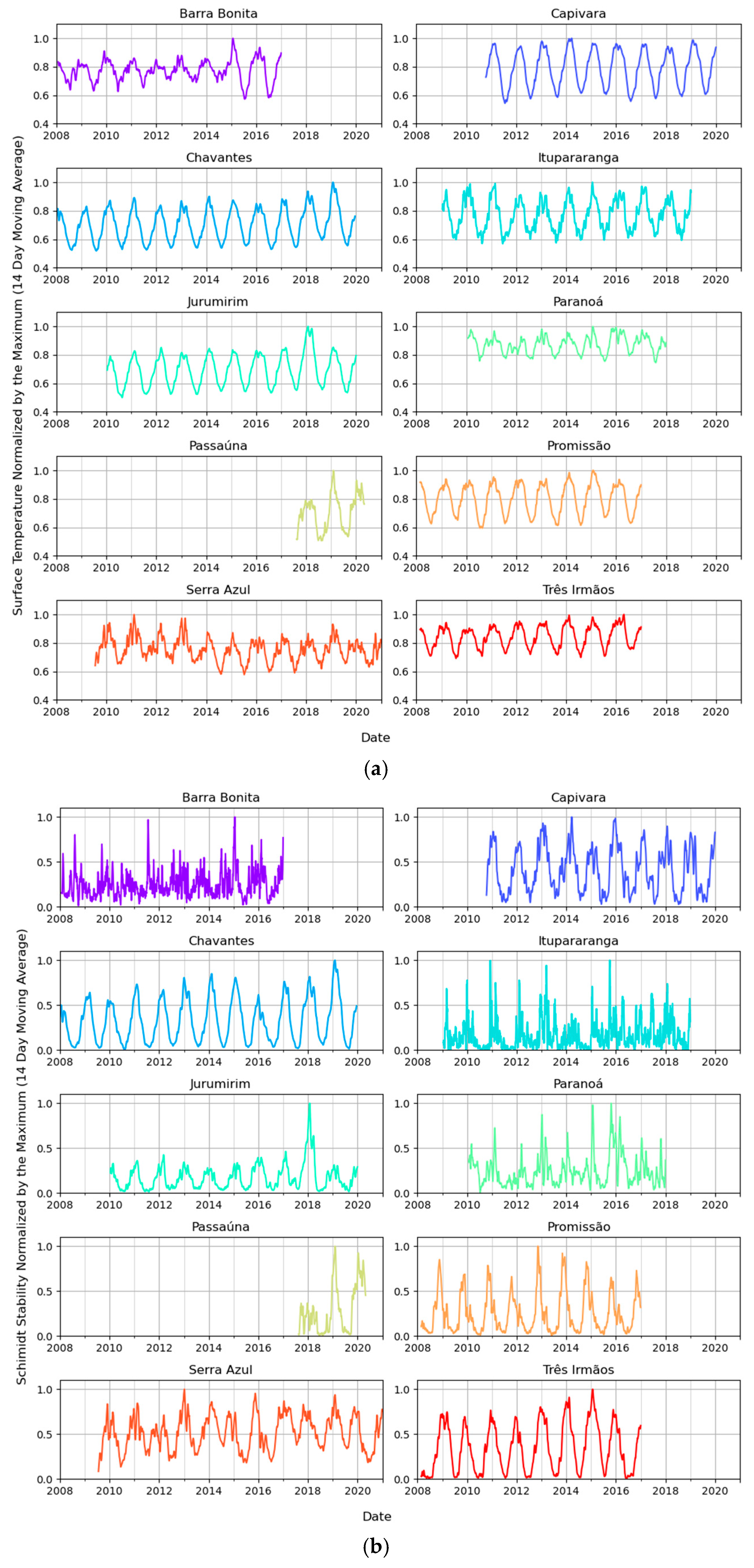
| Reservoir | Climate 1 | Main Use 2 | Max. Depth (m) | Surface Area (106 m2) | Total Volume (106 m3) | Residence Time (Days) | Thermal Regime Classification |
|---|---|---|---|---|---|---|---|
| Passaúna | Cfb | WS | 16.5 | 9.0 | 59 | 292 | Polymictic |
| Itupararanga | Cwa | WS, HP | 23.0 | 29.0 | 286 | 245 | Polymictic |
| Jurumirim | Cfa | HP | 39.5 | 485.0 | 7900 | 346 | Polymictic |
| Chavantes | Cfa | HP | 75.5 | 419.0 | 9400 | 284 | Polymictic |
| Capivara | Cfa | HP | 56.0 | 623.7 | 11,700 | 95 | Polymictic |
| Barra Bonita | Cwa | HP | 23.5 | 226.0 | 3160 | 91 | Polymictic |
| Promissão | Cwa | HP | 24.5 | 522.0 | 8110 | 141 | Warm monomictic |
| Três Irmãos | Cwa | HP | 45.6 | 654.0 | 11,460 | 442 | Warm monomictic |
| Serra Azul | Cwa | WS | 47.3 | 9.1 | 82 | 373 | Warm monomictic |
| Paranoá | Aw | WS, HP | 38.0 | 37.5 | 498 | 299 | Warm monomictic |
| Reservoir | Meteorological Station (Code and Name—INMET [25]) | Altitude (masl) | Latitude and Longitude (Datum WGS-84) | Time Period (YYYY-MM) |
|---|---|---|---|---|
| Passaúna | 83842—Curitiba | 924 | −25.45, −49.23 | 1990-01–2021-01 |
| Itupararanga | 83851—Sorocaba | 598 | −23.48, −47.43 | 2006-09–2018-12 |
| Jurumirim | A725—Avaré | 654 | −23.21, −49.23 | 2006-09–2021-10 |
| Chavantes | A821—Joaquim Tavora | 522 | −23.13, −49.73 | 2006-11–2021-10 |
| Capivara | A718—Rancharia | 350 | −22.66, −51.36 | 2006-09–2021-10 |
| Barra Bonita | A741—Barra Bonita | 534 | −22.47, −48.58 | 2008-04–2021-05 |
| Promissão | A735—José Bonifácio | 408 | −21.09, −49.92 | 2007-09–2021-05 |
| Três Irmãos | A704—Três Lagoas | 329 | −20.78, −51.71 | 2001-09–2021-05 |
| Serra Azul | A535—Florestal | 754 | −19.89, −44.42 | 2008-06–2021-05 |
| Paranoá | A001—Brasília | 1161 | −15.79, −47.93 | 1990-01–2021-03 |
| Category | Range | Reference Color |
|---|---|---|
| W—Normal/Wet | SPI ≥ −0.5 | |
| D0—Abnormally Dry | −0.7 < SPI < −0.5 | |
| D1—Moderate Drought | −1.2 < SPI < −0.8 | |
| D2—Severe Drought | −1.5 < SPI < −1.3 | |
| D3—Extreme Drought | −1.9 < SPI < −1.6 | |
| D4—Exceptional Drought | SPI ≤ −2.00 |
| Reservoir | Simulation Period (YYYY-MM-DD) | Calibration Period Validation Period (YYYY-MM-DD) | RMSE | |
|---|---|---|---|---|
| Water Level (m) | Temperature (°C) | |||
| Passaúna | 2017-08-01/2020-04-30 | 2018-03-01/2019-02-28 | 0.35 | 1.02 |
| Itupararanga | 2009-01-01/2019-03-31 | 2009-01-01/2013-12-31 | 0.63 | 1.30 |
| 2014-01-01/2019-03-31 | 0.45 | 1.34 | ||
| Jurumirim | 2009-01-01/2019-12-16 | 2011-03-01/2011-11-01 | 0.00 | 1.37 |
| Chavantes | 2009-01-01/2019-12-16 | 2011-03-01/2011-11-01 | 0.00 | 1.37 |
| Capivara | 2009-01-01/2019-12-16 | 2011-03-01/2011-11-01 | 0.00 | 0.96 |
| Barra Bonita | 2008-01-15/2016-12-31 | 2008-01-15/2012-12-31 | 0.93 | 1.79 |
| 2013-01-29/2016-12-31 | 0.89 | 1.82 | ||
| Promissão | 2008-12-02/2016-12-31 | 2008-02-12/2012-12-31 | 0.23 | 1.91 |
| 2013-01-28/2016-12-31 | 0.21 | 1.66 | ||
| Três Irmãos | 2008-02-12/2016-12-31 | 2008-02-12/2012-12-31 | 0.51 | 1.37 |
| 2013-02-26/2016-12-31 | 2.24 | 1.46 | ||
| Serra Azul | 2009-01-01/2016-12-31 | 2009-01-01/2012-12-31 | 0.74 | 1.33 |
| 2013-01-29/2016-12-31 | 0.74 | 2.06 | ||
| Paranoá | 2010-01-11/2017-12-31 | 2010-01-11/2017-12-31 | 0.29 | 1.09 |
| Reservoir | 4 Seasons (Significance Test) | |||||||
|---|---|---|---|---|---|---|---|---|
| Summer | Autumn | Winter | Spring | |||||
| F | p | F | p | F | p | F | p | |
| Passaúna | 338.89 | 0.000 | 251.37 | 0.000 | 46.41 | 0.000 | 26.76 | 0.000 |
| Itupararanga | 6.82 | 0.010 | 2.38 | 0.124 | 1.30 | 0.255 | 9.31 | 0.003 |
| Jurumirim | 32.48 | 0.000 | 10.88 | 0.001 | 49.35 | 0.000 | 12.03 | 0.001 |
| Capivara | 65.87 | 0.000 | 77.55 | 0.000 | 0.60 | 0.439 | 21.12 | 0.000 |
| Chavantes | 161.09 | 0.000 | 4.39 | 0.038 | 122.69 | 0.000 | 22.39 | 0.000 |
| Barra Bonita | 24.51 | 0.000 | 0.65 | 0.422 | 5.19 | 0.024 | 0.01 | 0.916 |
| Promissão | 16.35 | 0.000 | 0.12 | 0.731 | 2.17 | 0.143 | 5.63 | 0.019 |
| Três Irmãos | 485.67 | 0.000 | 62.64 | 0.000 | 0.74 | 0.392 | 12.75 | 0.000 |
| Serra Azul | 5.30 | 0.022 | 995.97 | 0.000 | 841.30 | 0.000 | 105.23 | 0.000 |
| Paranoá | 62.10 | 0.000 | 7.86 | 0.006 | 25.71 | 0.000 | 1.26 | 0.262 |
Disclaimer/Publisher’s Note: The statements, opinions and data contained in all publications are solely those of the individual author(s) and contributor(s) and not of MDPI and/or the editor(s). MDPI and/or the editor(s) disclaim responsibility for any injury to people or property resulting from any ideas, methods, instructions or products referred to in the content. |
© 2023 by the authors. Licensee MDPI, Basel, Switzerland. This article is an open access article distributed under the terms and conditions of the Creative Commons Attribution (CC BY) license (https://creativecommons.org/licenses/by/4.0/).
Share and Cite
Rigotti, J.A.; Carvalho, J.M.; Soares, L.M.V.; Barbosa, C.C.; Pereira, A.R.; Duarte, B.P.S.; Mannich, M.; Koide, S.; Bleninger, T.; Martins, J.R.S. Effects of Hydrological Drought Periods on Thermal Stability of Brazilian Reservoirs. Water 2023, 15, 2877. https://doi.org/10.3390/w15162877
Rigotti JA, Carvalho JM, Soares LMV, Barbosa CC, Pereira AR, Duarte BPS, Mannich M, Koide S, Bleninger T, Martins JRS. Effects of Hydrological Drought Periods on Thermal Stability of Brazilian Reservoirs. Water. 2023; 15(16):2877. https://doi.org/10.3390/w15162877
Chicago/Turabian StyleRigotti, Jucimara Andreza, João Marcos Carvalho, Laura M. V. Soares, Carolina C. Barbosa, Alice R. Pereira, Barbara P. S. Duarte, Michael Mannich, Sergio Koide, Tobias Bleninger, and José R. S. Martins. 2023. "Effects of Hydrological Drought Periods on Thermal Stability of Brazilian Reservoirs" Water 15, no. 16: 2877. https://doi.org/10.3390/w15162877
APA StyleRigotti, J. A., Carvalho, J. M., Soares, L. M. V., Barbosa, C. C., Pereira, A. R., Duarte, B. P. S., Mannich, M., Koide, S., Bleninger, T., & Martins, J. R. S. (2023). Effects of Hydrological Drought Periods on Thermal Stability of Brazilian Reservoirs. Water, 15(16), 2877. https://doi.org/10.3390/w15162877








